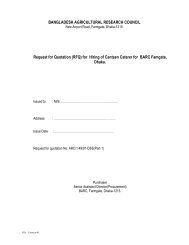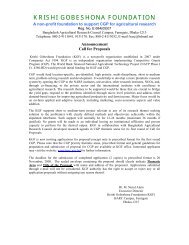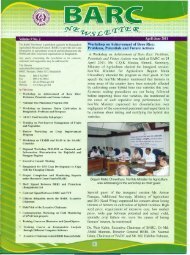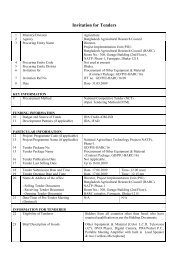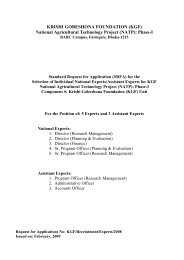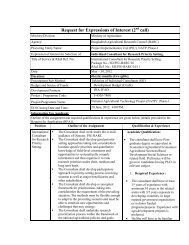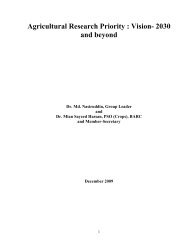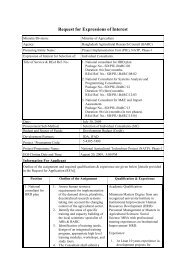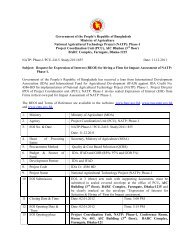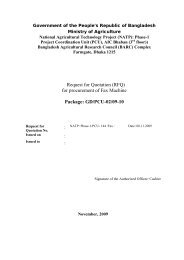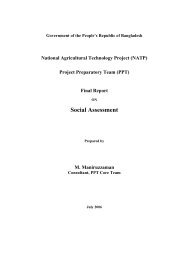ICT in Agriculture and Disaster Management - Bangladesh ...
ICT in Agriculture and Disaster Management - Bangladesh ...
ICT in Agriculture and Disaster Management - Bangladesh ...
You also want an ePaper? Increase the reach of your titles
YUMPU automatically turns print PDFs into web optimized ePapers that Google loves.
FAO<br />
Available reports show that the tropical <strong>and</strong> subtropical countries would be more<br />
vulnerable to the potential impacts of global warm<strong>in</strong>g. <strong>Bangladesh</strong> is likely to be one<br />
of the worst-hit countries of the globe, be<strong>in</strong>g an Asian as well as a Third World<br />
country.<br />
It is very likely that the soil sal<strong>in</strong>ity would <strong>in</strong>crease due to climate change <strong>and</strong><br />
consequential effects. Increased sal<strong>in</strong>ity would significantly decrease food gra<strong>in</strong><br />
production. This loss can be m<strong>in</strong>imized by varietal <strong>and</strong> agronomic manipulations.<br />
Reduction <strong>in</strong> food gra<strong>in</strong> production would put additional pressure to the food security<br />
of the country (Habibullah et al., 1999)<br />
Climate change <strong>in</strong> comb<strong>in</strong>ation with sea level rise would aggravate the soil sal<strong>in</strong>ity <strong>in</strong><br />
the coastal region of the country. A GCM model<strong>in</strong>g approach has <strong>in</strong>dicated that, under<br />
predicted climatic conditions the <strong>in</strong>dex of aridity will <strong>in</strong>crease dur<strong>in</strong>g w<strong>in</strong>ter (Ahmed<br />
et al., 1996).<br />
Accord<strong>in</strong>g to the Third Assessment Report of IPCC (2001) it is likely to have a 45 cm of<br />
sea level rise. Under this scenario, if no adaptation is assumed about 11 % of l<strong>and</strong> area<br />
of the country would be lost <strong>and</strong> also 5.5 million people would be vulnerable.<br />
Table 4. Some important statistics of the Coastal Zone of <strong>Bangladesh</strong><br />
Total L<strong>and</strong> Area (000 ha)P1P 14400<br />
Population <strong>in</strong> 2010 (millions) 141.82<br />
Population <strong>in</strong> 2020* (millions) 181.18<br />
Percent of population with<strong>in</strong> 100 km of the coast 55%<br />
Coastl<strong>in</strong>e Length (km)<br />
3306 (710 km coastal belt)<br />
Territorial sea (up to 12 nautical miles) (kmP2P) 40,257<br />
Claimed Exclusive Economic Zone (kmP2P) 39,868<br />
*Estimated population, P1P<br />
(2008).<br />
Source: WRI (2000). Coastl<strong>in</strong>e=This entry gives the total length of the boundary between the<br />
l<strong>and</strong> area (<strong>in</strong>clud<strong>in</strong>g isl<strong>and</strong>s) <strong>and</strong> the sea<br />
Sal<strong>in</strong>ity Intrusion<br />
In the w<strong>in</strong>ter months the areas suffer due to sal<strong>in</strong>ity related problems. In absence of<br />
appreciable ra<strong>in</strong>fall the soil <strong>in</strong> the coastal areas starts to desiccate, <strong>and</strong> because of<br />
capillary actions salt comes up at the surface of the soil <strong>and</strong> accumulates <strong>in</strong> the root<br />
zones of crops. Many of the crop varieties are not tolerant to sal<strong>in</strong>ity, <strong>and</strong> as a result, a<br />
large area <strong>in</strong> the coastal districts becomes virtually unsuitable for a number of crops,<br />
while the production of a few other crops is lesser under sal<strong>in</strong>e conditions.<br />
Most of the l<strong>and</strong> rema<strong>in</strong>s fallow <strong>in</strong> the dry season (January- May) because of soil<br />
sal<strong>in</strong>ity, lack of good quality irrigation water <strong>and</strong> late dra<strong>in</strong><strong>in</strong>g condition. Farmers<br />
cultivate mostly low yield<strong>in</strong>g, traditional rice varieties dur<strong>in</strong>g wet season. The process<br />
of sal<strong>in</strong>ization is governed by many factors among which the dom<strong>in</strong>ant ones are l<strong>and</strong><br />
characteristics <strong>and</strong> dra<strong>in</strong>age of tidal flood<strong>in</strong>g through a network of tidal creeks <strong>and</strong><br />
dra<strong>in</strong>age channels <strong>in</strong>undates the soil <strong>and</strong> impregnates them with soluble salts thereby<br />
render<strong>in</strong>g the topsoil <strong>and</strong> subsoil sal<strong>in</strong>e. With<strong>in</strong> the embankment the sedimentation<br />
<strong>and</strong> <strong>in</strong>undation process with sal<strong>in</strong>e water <strong>in</strong> brackish water shrimp cultivation area are<br />
still active. Only about six percent of the l<strong>and</strong> types <strong>in</strong> coastal area are highl<strong>and</strong> <strong>and</strong><br />
13% medium low l<strong>and</strong>. The dom<strong>in</strong>ant l<strong>and</strong> type <strong>in</strong> this region is medium highl<strong>and</strong>,<br />
which is about 64%. A comparative study of soil sal<strong>in</strong>ity maps of 1973, 2000 <strong>and</strong> 2009<br />
27





